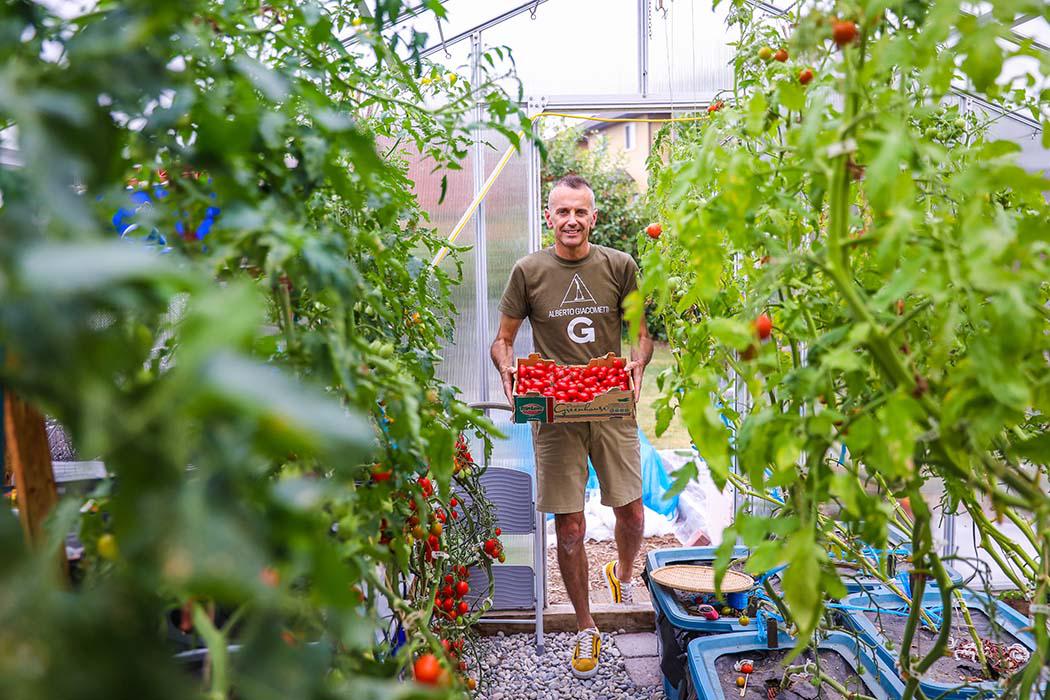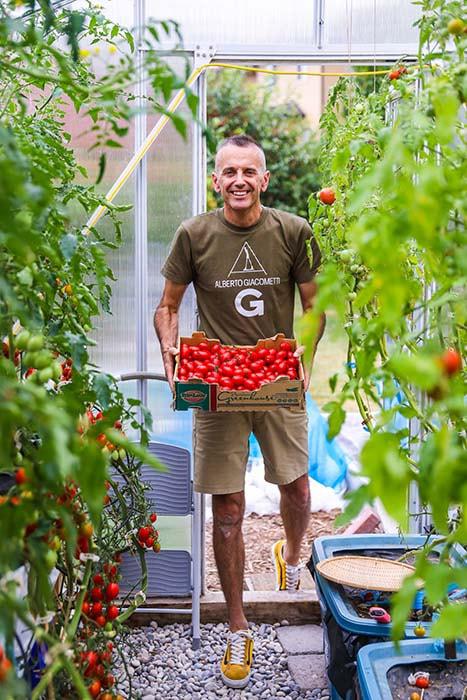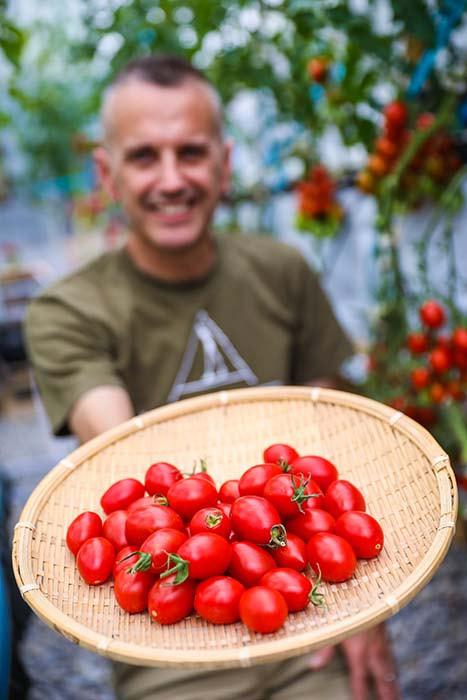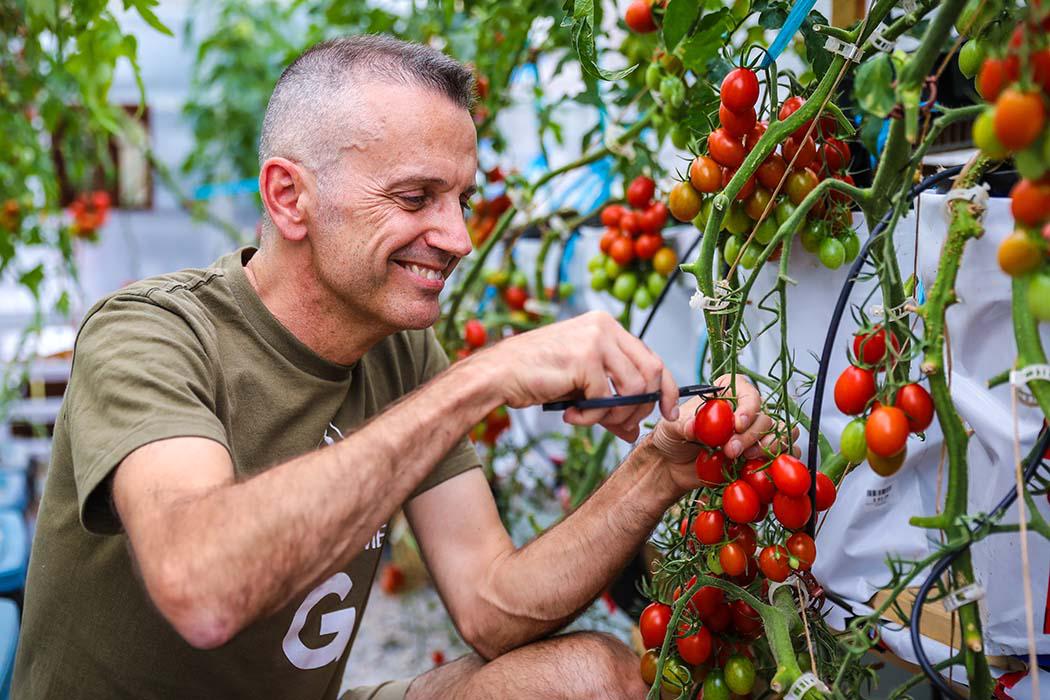“The sheer range of tomatoes coupled with amazing stories of families diligently saving their prized tomatoes and bringing them with them from the Old World makes it an honour to continue to grow them today”
Airdrians have good taste. Some even make it their hobby. This issue, we caught up with Jeff Casey, of Casey’s Heirloom Tomatoes, who grows gorgeous gems in his own backyard.
airdrielife: When did you start growing tomatoes? What got you hooked?
Jeff Casey: I started growing tomatoes while I was living in Hokkaido, Japan, teaching English on the Japan Exchange and Teaching Program in 1995. I came back to Canada and tried to grow tomatoes in Airdrie, and the four hybrid varieties that were available from the garden centre didn’t perform for me. With the advent of the Internet, I came across Craig LeHoullier (author of the book Epic Tomatoes, which lists me as a source for heirloom tomato seeds), who provided a comparison of the performance of hybrids and heirloom tomatoes. I never knew so many different colours (red, pink, yellow, orange, white, green-when-ripe, black, bi-colour and striped), sizes (from small cherries to 900+ gram beefsteaks) and shapes (round, oblate, pear, plum and ruffled) of tomatoes were available.
The sheer range of tomatoes coupled with amazing stories of families diligently saving their prized tomatoes and bringing them with them from the Old World makes it an honour to continue to grow them today. Every year, people send me tomato seeds that their ancestors grew for generations, or resulting from a mutation in their gardens, wanting me to make them more widely available. It is an honour to be trusted with ensuring the genetic diversity of open-pollinated tomatoes.
AL: What is your secret to growing the perfect tomato?
JC: The secret to growing the perfect tomato here is to provide your plant with heat, especially during the night. Tomatoes stop growing when the temperature falls below 15 C so the most prized microclimate in your yard needs to be devoted to your tomatoes. I grow most of my plants in a greenhouse.
Stress your plants! A little water stress will increase the sweetness and flavour of your tomatoes. But as in humans, too much stress will result in problems (such as BER – blossom end rot – in tomatoes). Make sure your soil is amended with plenty of organic matter.
AL: Describe the varieties you choose to grow and why.
JC: I make available 100+ different tomato varieties for my seed business. Broadly speaking I try to find varieties that represent the broad spectrum of tomato flavours, from tropical fruitiness, melon-like sweetness and sugary sweet to the complex flavours of a large pink beefsteak, the rich full-tomato flavour of a red, or the smokiness of a black tomato. In addition to flavour, I also consider texture (meatiness, firmness), size and shape and the history of a tomato variety. Overarching all of those factors is to ensure that most will grow in our area.
AL: If you could eat only one tomato, what would it be?
JC: Maya and Sion’s Airdrie Classic. I received these seeds from Dr. Carolyn Male. She wrote the very first book about heirloom tomatoes, 100 Heirloom Tomatoes for the American Garden. Dr. Male distributed seeds from a cross between a large pink beefsteak Brandywine and a very early Czechoslovakian called Stupice. I grew that tomato out for seven generations, selecting for the earliest, best-tasting tomato to stabilize it. I named it after my son, Sion, and daughter, Maya, and the town that I love. I added the word ‘classic’ to make people aware of the classic tomato flavour it possesses.
AL: How many tomatoes did you harvest last year?
JC: I am not sure of how many pounds but during the height of my season tomatoes are everywhere in the kitchen – on the table, every inch of counter and in boxes on the floor – ready for processing and selling as fresh fruit.
AL: Describe the process of harvesting seeds. Is this a lost art?
JC: The process itself is quite simple: I bag my blossoms to prevent cross-pollination, choose the best of harvest, cut the tomato in half or quarters, squeeze out the juice, seeds and pulp into a cup, let it sit to ferment (which takes about five to seven days), remove the fungal mat, rinse the seeds to remove any small floater seeds as they will not germinate, keep rinsing until the water runs clear, place the seeds on a coffee filter to dry, and finally, place the seeds in a container or envelope and store in a cool, dry location.
Little-known fact: tomato seeds will be viable for 10 years, but expect about 10 per cent drop in germination rates each year. For the first four years or so, you probably will not even notice a difference in germination rates. I would not say it is a lost art; rather people’s lives are so busy that they just don’t have the time to save seeds.
AL: How far away do your seeds get shipped?
JC: I have sent my seeds all over the world: the United States, Uruguay, Iceland, Europe-UK, France, Belgium, Switzerland, Germany, Russia, Belarus, Australia, New Zealand, Japan, South Africa and all over Canada.
AL: Finish this sentence: “When I am not in my greenhouse, I am….”
JC: In my garden tending to my other vegetables!
AL: Can you share your favourite tomato-based recipe with us?
JC: Sicilian Rouge tomatoes have three times the glutamate than normal tomatoes, which makes them the only tomato I have ever tasted that has umami (richness). To bring out the umami one must cook the tomatoes.
Sicilian Rouge Pomodoro Pasta
320 g Sicilian Rouge tomatoes
160 g spaghetti
60 g extra virgin olive oil
1 clove garlic
6 leaves basil
1 hot pepper (optional) 1
Remove the skin from the tomatoes. Cut an “X” on the blossom end of each tomato. Drop the tomatoes gently into a pot of boiling water. Remove after 10 seconds and place in an ice bath. The skins can now be easily peeled with a knife.
Add spaghetti to boiling water; cook to al dente.
Add thinly sliced garlic (and chopped hot pepper, optional) to a fry pan with the olive oil over low heat. Once the garlic has turned a light-brown colour, add the peeled tomatoes to the fry pan.
Crush the tomatoes while they cook over high heat. Cook until the sauce thickens.
Add pasta to the fry pan, tear basil into small pieces and add to the mix. Toss until well coated with sauce.
Top with Parmesan cheese and a drizzle of extra virgin olive oil.











